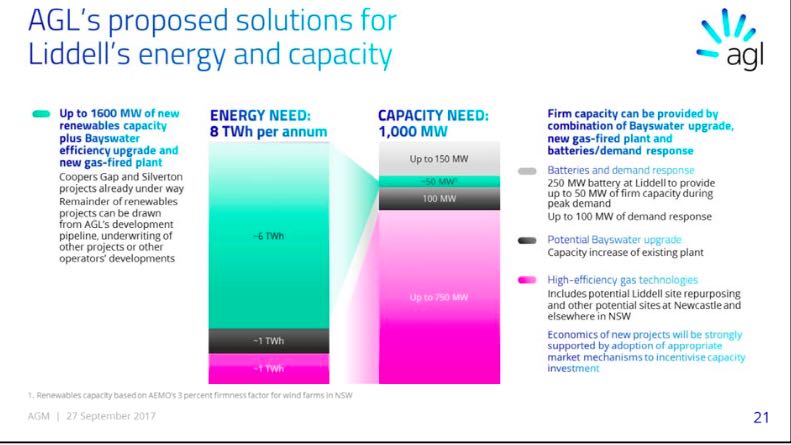AGL has outlined plans for battery storage, gas-fired power, renewables and upgrades to other power plants to replace the Liddell Power Station.
In April 2015, AGL committed to closing its conventional coal-fired power stations at the end of their operating lives as part of its Greenhouse Gas Policy. In the case of Liddell this is in 2020.
At AGL’s annual general meeting, Managing Director and CEO of AGL, Andy Vessey, announced the potential plans after Liddell’s closure to replace the eight terawatt hours a year of energy that Liddell provides and the 1,000-megawatt reserve capacity shortfall.
“We believe the bulk of the eight terawatt hours of energy needed to match Liddell’s output can come from new renewables projects, as we believe this is the most cost-effective option,” Mr Vessey said.
“That would include our Coopers Gap and Silverton projects already under construction, other projects from within our pipeline, and other companies’ projects as well. And, of course, the intermittency of wind and solar generation means additional firm, flexible, dispatchable capacity is also required.
“We can provide the 1,000 megawatts of capacity needed through a combination of upgrades to the Bayswater Power Station that adjoins Liddell, construction of new high-efficiency gas-fired power plants, and development of battery and demand response solutions.
“We see batteries at Liddell, as well as demand response solutions, providing up to a further 150 megawatts of firm capacity.”

“Our projects to increase gas supply will support the economics of these projects, which we believe will comprise up to 750 megawatts of new capacity,” Mr Vessey said.
“Gas development again at Liddell would take advantage of existing infrastructure as well as the connections to the electricity grid.
“We are also examining the potential for gas development at Newcastle and elsewhere in New South Wales.
“Our plans will be flexible, enabling us to increase or decrease our own investment depending on the broader response of the market to price signals and policy certainty.”
Mr Vessey also outlined a plan and time frame for the solution to the supply problem.
“Highly efficient, flexible gas plant can be quick to develop and, given its modular design, installed in stages,” Mr Vessey said.
“We believe initial capacity would begin to be constructed from 2019 and up to 750 megawatts would be in place at various sites by the time of Liddell’s announced closure.
“We will deploy both grid-scale batteries, as well as residential batteries combined with orchestration technology to enable customers to participate in and benefit financially from demand response.
“Upgrades to Bayswater can begin as early as 2019. Finally, we have 653 megawatts of renewables under development at Coopers Gap and Silverton and more than 3,000 megawatts of additional renewables projects in our development pipeline.”
AGL will present its plans to the Prime Minister and AEMO by early December 2017.
















